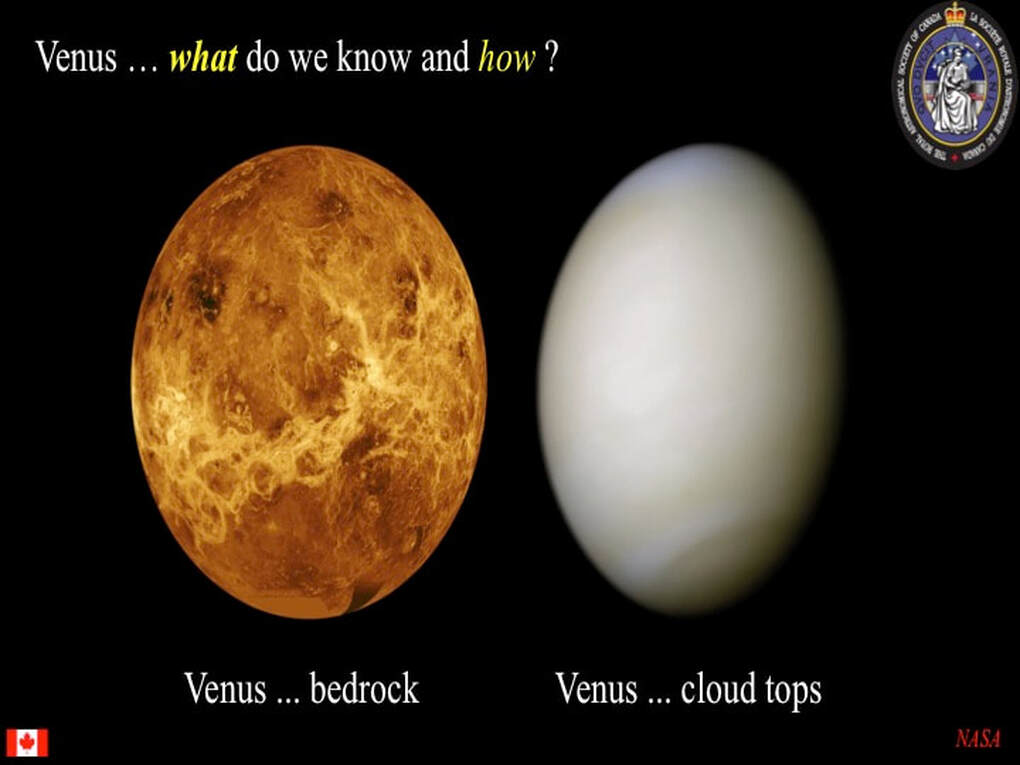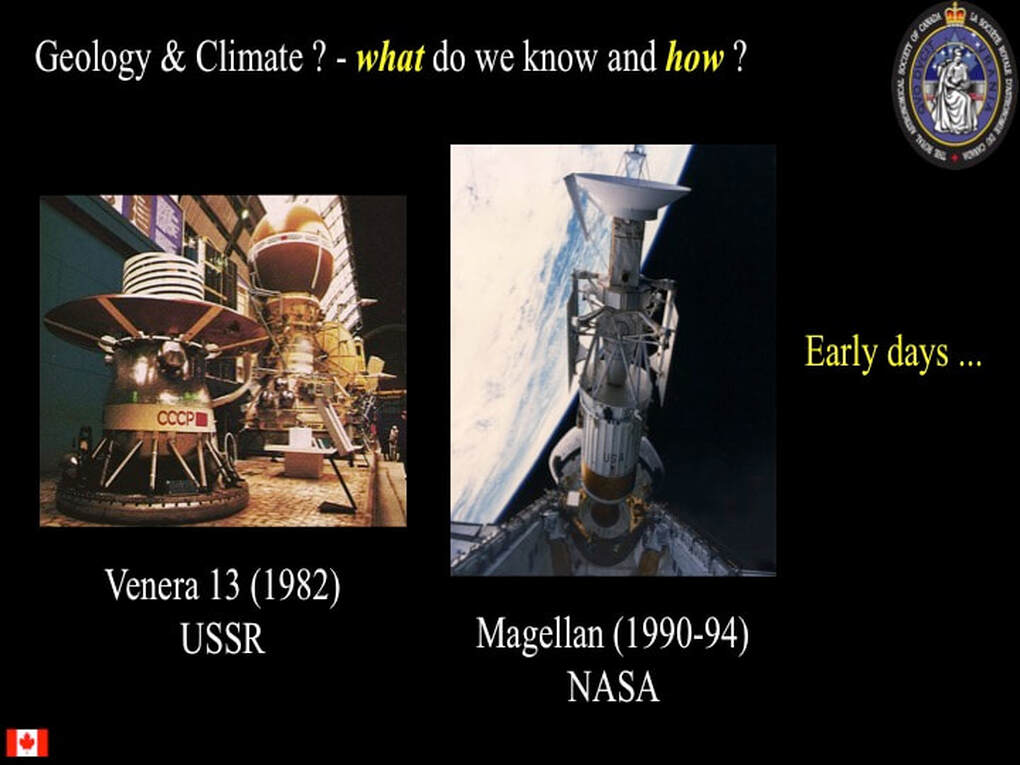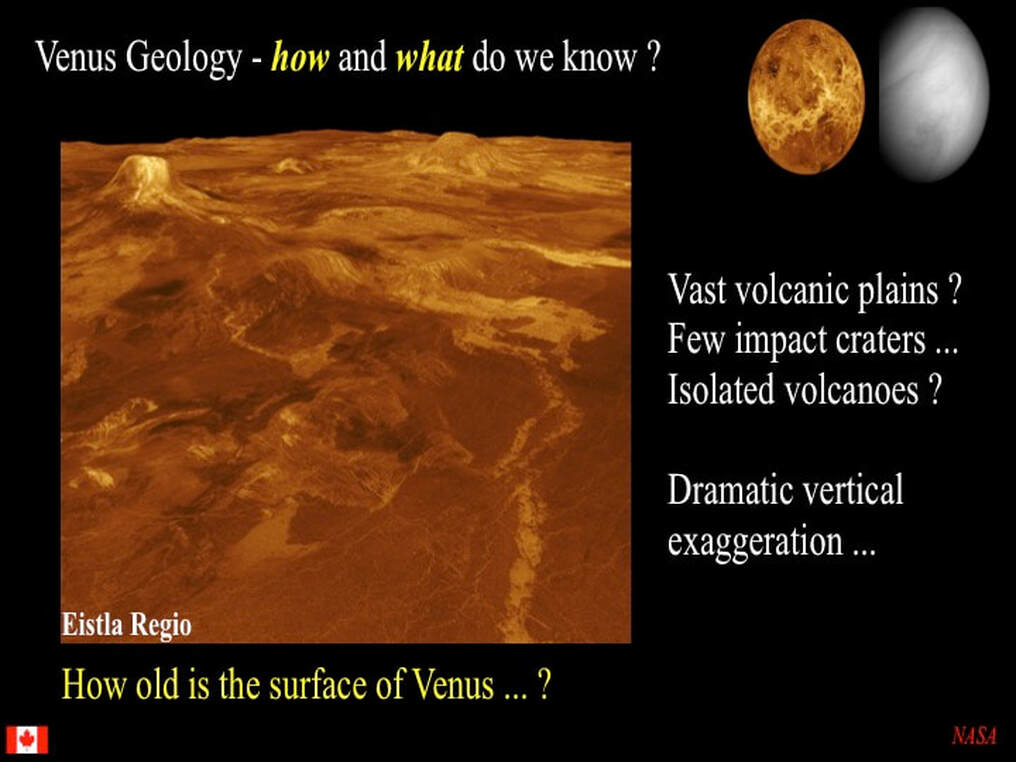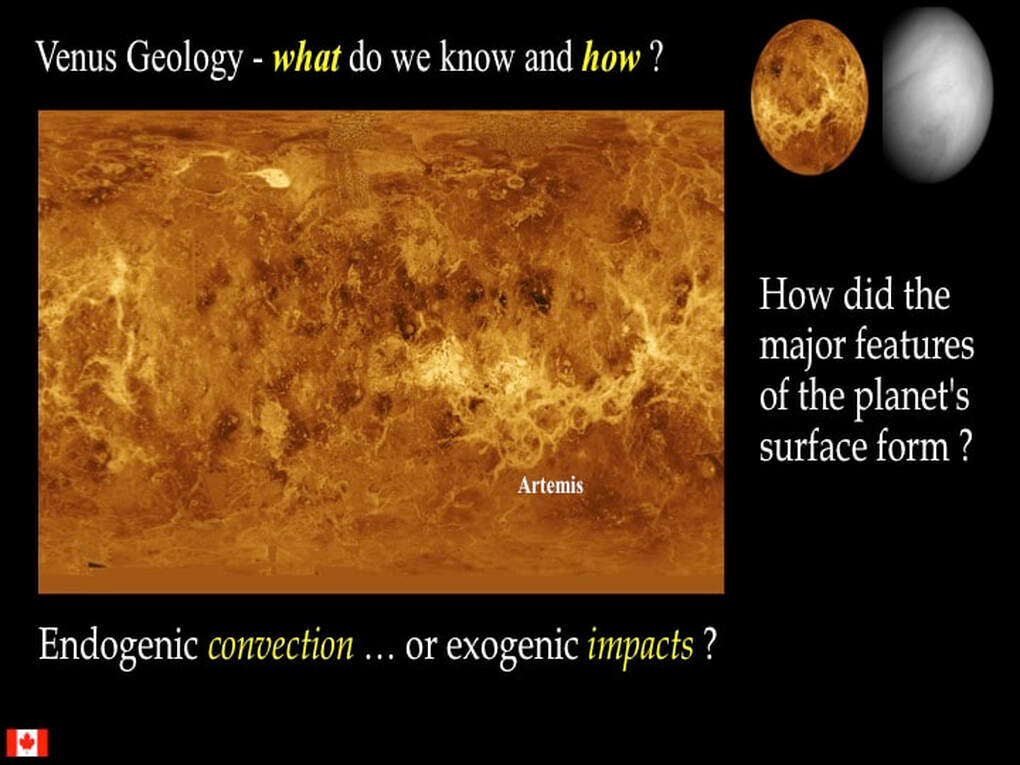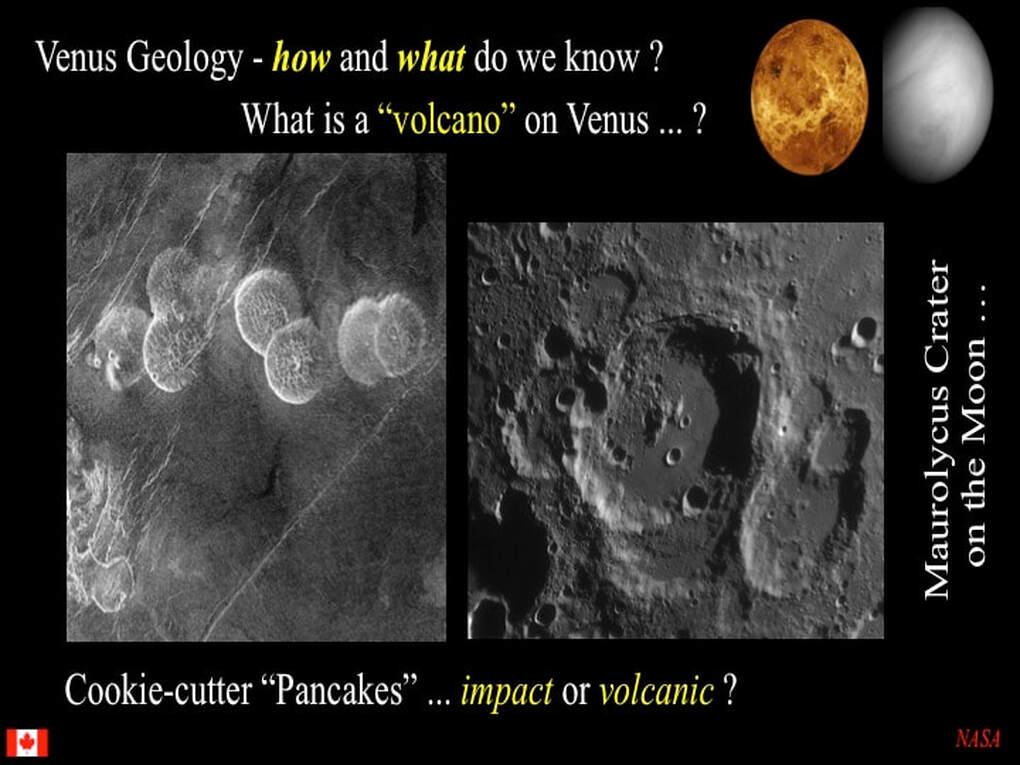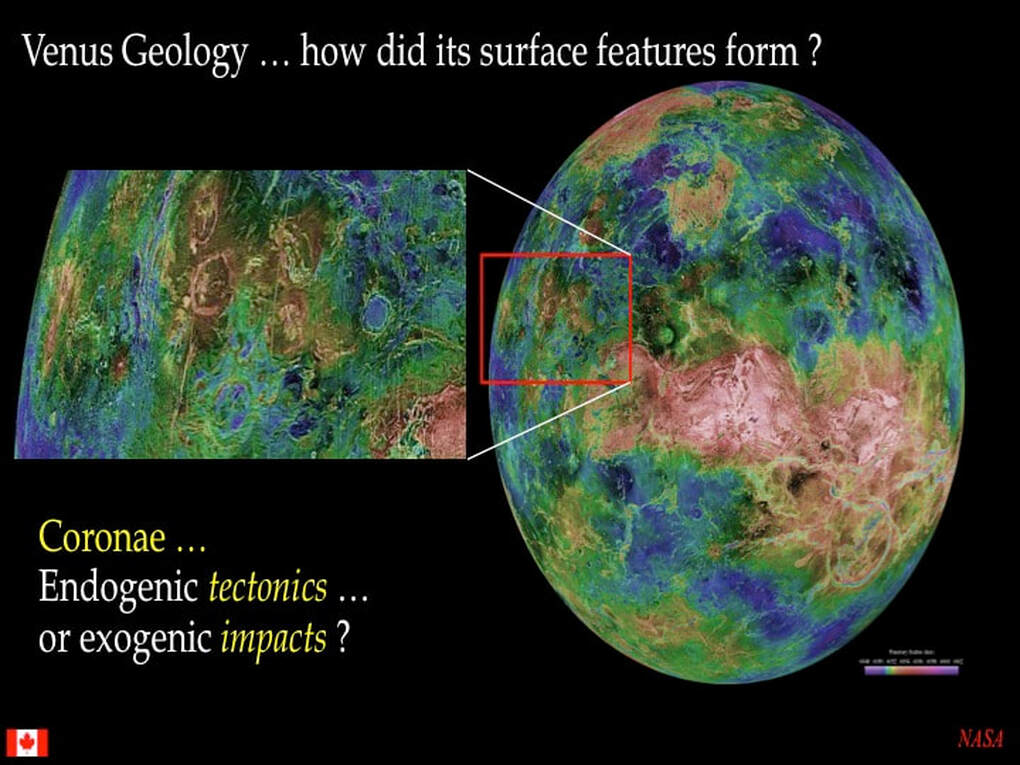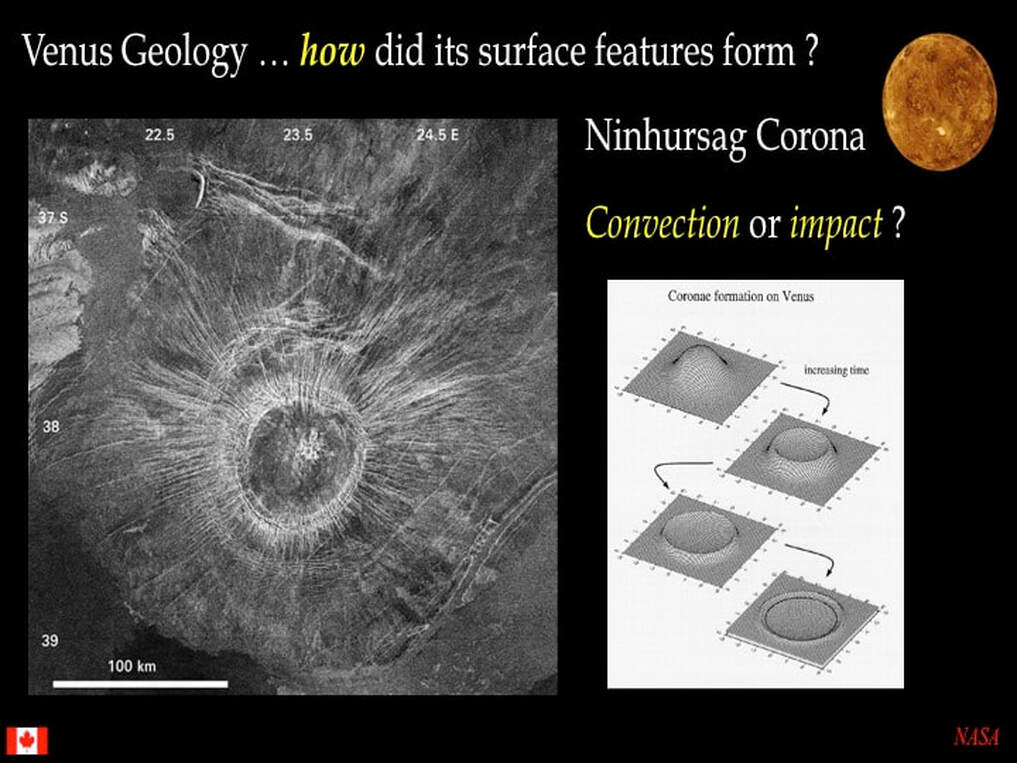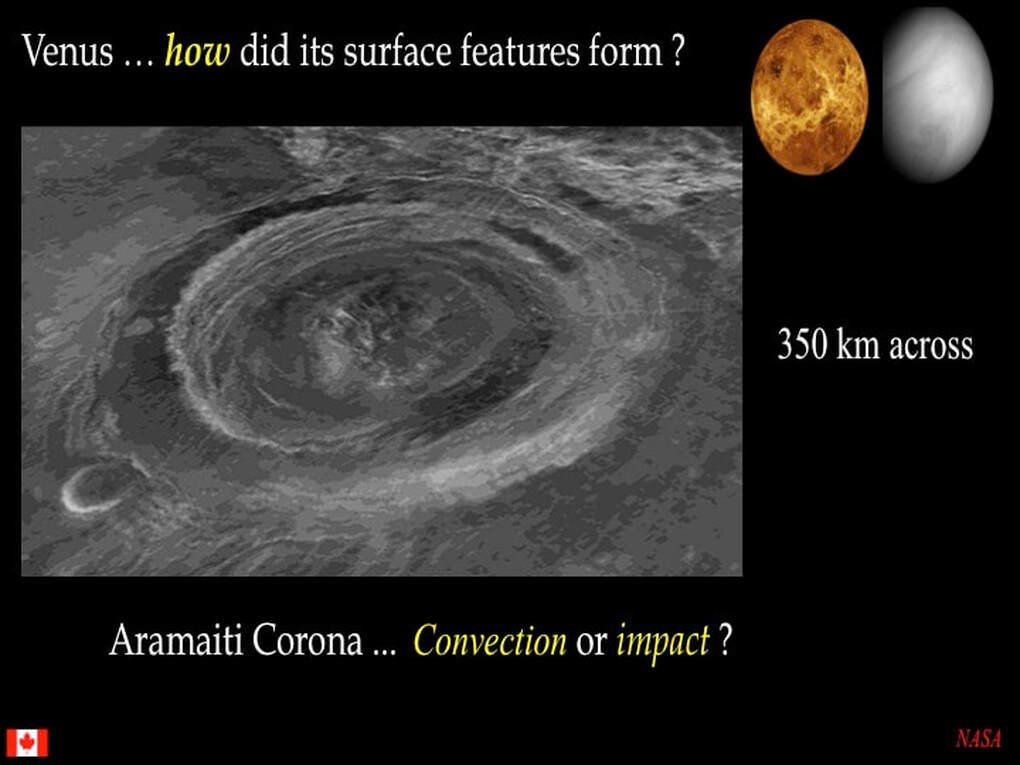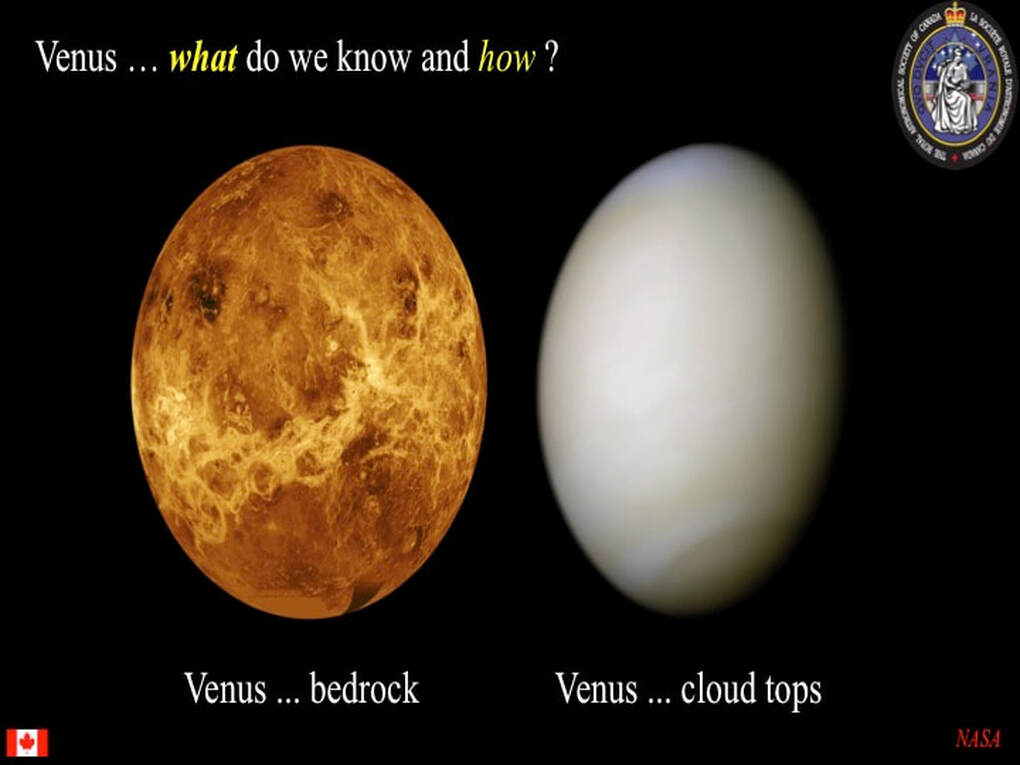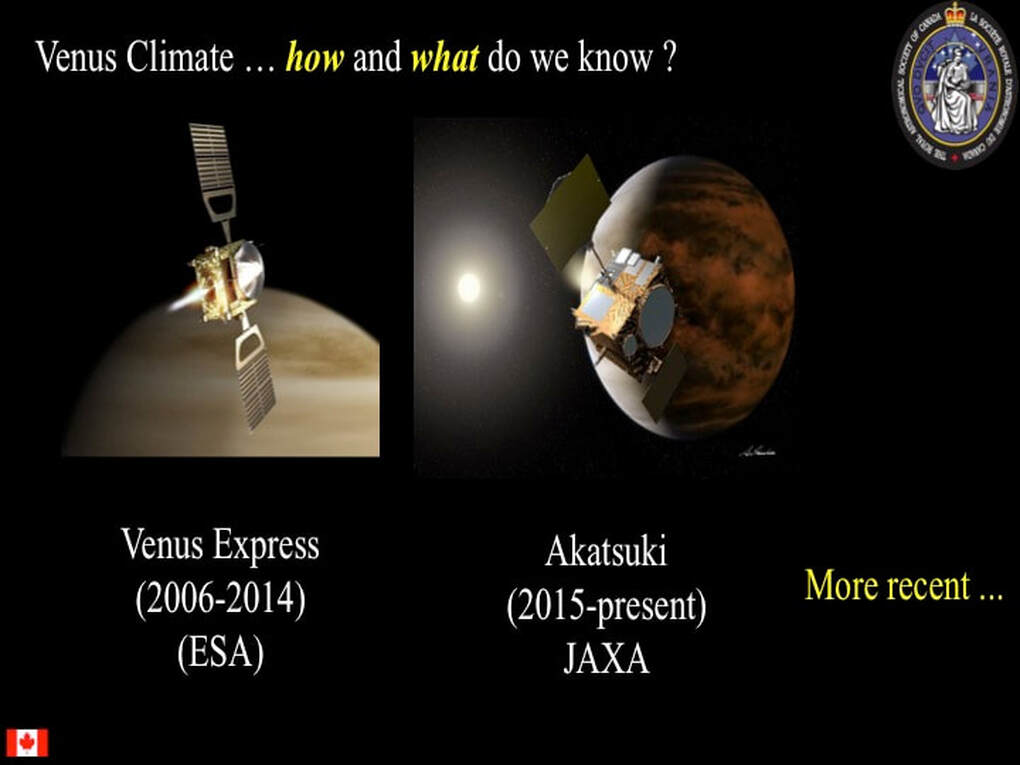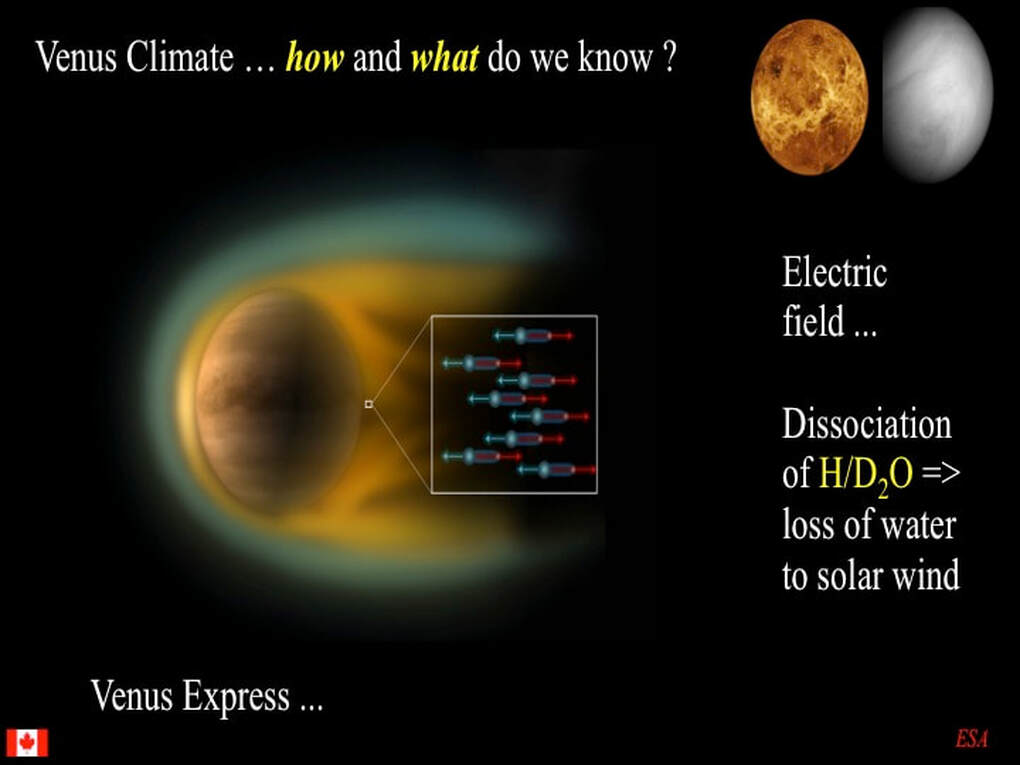|
VENUS SCIENCE in 2020
|
In the second half of last year I gave presentations at this podium on the status of scientific inquiry regarding the Moon (https://www.simonhanmer52.ca/lunar-science-in-2019.html) and Mercury (https://www.simonhanmer52.ca/mercury-2019.html). In light of the speed of scientific advance, I wanted to focus on the questions that planetary scientists are asking themselves today about the bodies that comprise our Solar System. Given the breadth of scientific endeavour today - a reflection of the pressure to publish to obtain funding, whatever the discipline - I opted to avoid the detailed stuff and to focus just on the big picture questions ... such as "Why is Mercury such a weird planet ?" : let's not worry about all the scratch marks ! Here, I'd like to turn the spotlight on Venus ... and Venus is a very different kettle of fish, It is one of those cases where the science is really not advancing at a significant pace, In fact, from my perspective, Venus Science seems to be bogged down in dispute and controversy , as opposed to advancing toward enlightenment !
As amateur astronomers, when we think about terrestrial planets we tend to be strongly influenced by what we know of Mars, Mercury and the Moon. However, all three are visible to us in white light and at pretty good resolution : all we have to do is look, even if we are looking at the internet ! Venus, on the other hand, is very different : it is shrouded by a deep and dense atmosphere mostly made of CO2 clouds. Hence the best way to see the ground is by using radar - and therein lies the fundamental problem for venusian science.
The last probe sent to Venus with the explicit aim of mapping the bedrock surface using radar (and some other wavelengths) was NASA's Magellan probe of the early 1990s. This means that scientists studying venusian geology have been working with the same (old) data set for the past 30 years. While better than what we had before, these data are pretty coarse in terms of resolution (~120-300 m/pixel), so a lot of necessary detail is simply not resolvable. Nevertheless, a great deal has been accomplished. However, Venus has not been the centre of attention for the World's national space agencies for a long time : it is clearly the poor relation compared with Mars and the Moon ... both scientifically and politically !
One of the consequences of this is that the venusian scientific community tends to be relatively small ... and relatively isolated. From my biased point of view, venusian science is dominated by physicists and chemists, and suffers from a lack of cross-fertilisation with geologists, especially those with field experience ... but, as I say, I'm biased ! Recently, however, there is something new in the air : groups of scientists are beginning to push more forcefully for the funding of new science missions to Venus, principally driven by two politically popular imperatives : climate change and exoplanets and the search for life outside of our Solar System. Bedrock geology is currently seen as a secondary or tertiary priority, though it won't be altogether ignored. We'll look what this means at the end of the presentation. However, before we look at where Venus Science might possibly be going in the near future, we should take a moment to consider where we are today : what we think we know and how we got there.
One of the consequences of this is that the venusian scientific community tends to be relatively small ... and relatively isolated. From my biased point of view, venusian science is dominated by physicists and chemists, and suffers from a lack of cross-fertilisation with geologists, especially those with field experience ... but, as I say, I'm biased ! Recently, however, there is something new in the air : groups of scientists are beginning to push more forcefully for the funding of new science missions to Venus, principally driven by two politically popular imperatives : climate change and exoplanets and the search for life outside of our Solar System. Bedrock geology is currently seen as a secondary or tertiary priority, though it won't be altogether ignored. We'll look what this means at the end of the presentation. However, before we look at where Venus Science might possibly be going in the near future, we should take a moment to consider where we are today : what we think we know and how we got there.
Until quite recently, most of what we knew about Venus came from data sent back by the Russian Venera Mission and NASA's Magellan Mission, in the 1980's and 1990's respectively. In fact, with few exceptions, pretty much everything we know about the geology of Venus stems from these two missions.
This is probably the most widely reproduced image from the Venera Mission : the ground at the feet of the lander that only lasted a couple of hours in the venusian heat (>450° C). The slabby nature of the rock was taken to represent thin lava flows, but there's a school of thought today that says these might be ancient sediments ... deposited in ancient water.
This quintessential radar image of the surface of Venus was captured by the Magellan Mission ... then processed by NASA to improve its communications value. What you see here are extensive low-lying, rolling plains dotted by a couple of high-standing, overly-processed volcanoes. The most important thing in this image is the general lack of visible impact craters. For various reasons, all related to impact crater statistics across the Solar System, especially the Moon - and on Venus itself - this has been taken to mean that Venus has been resurfaced by relatively recent lava flows on a planetary scale, thereby covering and hiding any trace of its early impact history (think : re-asphalting municipal roads to cover and hide potholes). Originally, it was suggested that a catastrophic event occurred sometime during the last 1 billion years whereby older crust sank into an over-heated, melted planetary mantle that in turn sent new magma to the surface to form a new volcanic crust, plus some localised volcanoes (https://www.simonhanmer52.ca/venus--earth.html). However, more recent thinking - still based on impact crater statistics - now raises the possibility that this renewal of the planetary surface may have occurred piece-meal and over an extended time frame in a non-catastrophic, steady-state fashion. It turns out that there are all sorts of geophysical reasons, related to the internal nature of the planetary mantle, that provide potential support for this non-catastrophic, steady-state view. So the #1 geological question that planetary scientists are still asking themselves about Venus is how and when did the surface we see today form ? ... and that's a pretty fundamental question for an entire planet !
The next fundamental geological question for Venus is highly controversial ... and remains unresolved : "Are the major features that mark the surface due to internal or external processes ?" By major features I mean a variety of generally round, plateaus, doughnuts and holes that measure hundreds to thousands of km across and occur all over the planet. Check out Artemis for scale (2000 km across). By "internal processes" (endogenic) I mean hot, bouyant planetary interior material rising up and deforming the planetary surface. By "external processes" (exogenic) I mean impacts by large bolides (asteroids) from space. This is another pretty fundamental question to be asking about an entire planet. Surely we should be able to tell the difference between these two possibilities. Well ... maybe !
Try this visual test. This is a radar image of a crater on Venus : it's about 100 km across. What do you think : is it of volcanic (internal / endogenic) or impact (external / exogenic) origin ? The long run-out to the right - 600 km long - certainly looks like something that has flowed out of the round crater. But don't be fooled ... it's not a volcanic lava flow. If the round structure was a volcanic crater, then where's the giant volcano it should be assocated with ?
What are the short "petal-like" features at top right, similar in texture to the rest of the periphery around the crater ? Compare this crater with another - about half the size of the first - clearly an impact crater of external or exogenic origin. Addams crater is indeed a well known impact feature, and the long run-out is either impact ejecta or impact melt. The take-home message from this image is that you really have to think about craters on Venus before jumping to conclusions. Some scientists - in the minority mind you - have suggested that this is exactly the case with respect to many - if not most - of the purported volcanic features all over the venusian surface. Let's take a look at why...
This pair of images shows an overhead view and a perspective view of domes , each between 50 and 100 km across, thought to be unique to Venus. Note that the perspective view has a dramatic vertical exageration that gives the false impression of near-vertical sides to the domes. The domes are classically interpreted as volcanoes made of very stiff (viscous) magma or - more recently - as piles of volcanic crystals. In any event, they are assumed to be of internal (endogenic) origin. However, as pointed out by the dissident minority - primarily represented by the late Warren Hamilton - younger domes cut across older domes in cookie-cutter fashion, without any deformation of the earlier domes. Geologically, this would be rather extraordinary. Something pushing up from the interior of a planet against something already at the surface should distort both the planetary surface and the shape of the earlier feature, but this is not what we observe, So, the dissident minority opinion group asks : "Where else in the Solar System do we see large, round, cookie-cutter features ... ?"
... and the answer is : on impact cratered terrains, such as the Moon or Mercury. The dissenting minority then goes on to suggest that the venusian features are in fact crystallised lava ponds that were produced by the heat of external (exogenic) impacts, and not internal volcanism after all ! Are they right ? I don't know ... but they do ask a very valid question that the majority of workers have simply ignored.
This question of internal or external driving mechanisms also applies to features that measure 100's to 1000's of km across, apparently unique to Venus and referred to as "Coronae". This image shows you what they look like -and their distribution all over the planet.
Here we see a close-up of a corona feature, plus a cartoon of how it might have formed according a model of internal (endogenic) convection. The general idea is that a large mass of bouyant hot rock would have risen from within the planet, domed up the planetary surface, cooled and densified, and sunk back down aways, leaving a large, round dimple on the planetary surface. The radiating spokes likely represent vertical sheets of molten rock (magmatic dykes) injected into the up-domed and stretched crust.
However, the minority dissenting view says that many of these corona features look very much like large impact craters with a central peak, plus raised and slumped walls, all surrounded by a ring of impact ejecta. In other words, they are the result of an external (exogenic) mechanism - and not internally driven at all.
They argue that if coronae were the product of rising mushy rocks from within the planet ... then, where they overlap, the younger coronae should distort the older ones. In short, the older coronae should no longer be round. But as you can see in these three images, this is not what we see on Venus. The coronae in two of the images are numbered such that #1 is the youngest. What you see here is that the successively younger coronae are superimposed on the older coronae in cookie-cutter fashion ... rather like a hole-punches in paper. This, they argue, can only be achieved by externally derived impacts ... and large impacts at that. Remember what we just saw with respect to overlapping impact craters on the Moon. Are they right ? Once again, I don't know ... but yet again they are asking a very valid question that the majority of workers continue to simply ignore. Internal or external processes ... we resolved this on the Moon half a century ago !
However, let's be very clear ... just because some important surface features might be generated by external processes, doesn't automatically mean that the interior of the planet was not geologically active ... and therefore convecting.
However, let's be very clear ... just because some important surface features might be generated by external processes, doesn't automatically mean that the interior of the planet was not geologically active ... and therefore convecting.
Let's now switch gears now and briefly look at the geology of Venus as a planet at the global scale. This global map of Venus distinguishes high ground (pinks) from low ground (greens and especially blues). The low ground is principally occupied by the lava plains that resurfaced the planet, however and whenever that occurred ! Some of the high ground is considered to represent the oldest rocks on Venus : massifs known as crustal plateaux (pink). These crustal plateaux have been the subject of much intensive research for the past 30 years, principally because it was thought that they held clues that might explain how the crustal plateaux themselves formed above convecting cells within the early, hot planet. One school of thought concluded that the crustal plateaux formed over rising plumes of hot rocks, while another school of thought arrived at the opposite conclusion : crustal plateaux formed over sinking plumes of cold rocks. Then a new school of thought concluded that neither hypothesis was valid, and proposed that crustal plateaux were the product of truly massive asteroid collisions ... and if this sounds to you like the internal / external (endogenic / exogenic) debate all over again ... you would be correct ! However, I have to warn you that an entire school of thought suggests in fact the interior of the planet was too dry and too stiff for it to convect at all : more controversy, but that's a topic for another day !
I could go on with more examples, but in short, when it comes to even the broadest outlines of the geology of Venus, there's a great deal that we still don't understand, and I haven't even touched on the detailed stuff here. But there's more to Venus as a planet than its bedrock geology and geophysical theories regarding its interior. More recently, the main feature of scientific interest has been its atmosphere and climate.
During the past 15 years, both NASA and JAXA (Japanese Space Agency) have sent probes into Venus orbit, specifically to investigate the atmosphere of Venus.
JAXA's Akatsuki ("Dawn") mission has focused on mapping the structure of the atmosphere as well as the nature of its winds and clouds.
This diagram summarises some of the results ... and if it looks "busy", well - that's the nature of atmospheric science. I liken it to 3D chess where even the chessboard is constantly moving and changing.
NASA's now completed Venus Express mission also studied the venusian atmosphere in great detail, but I'd like to highlight just one tangible finding that came out of that mission. One of the big questions scientists have been asking about Venus as a planet is whether it ever had significant quantities of water, perhaps even surface water ... oceans ? The evidence stems from comparing D/H ratios of Venus and the Earth. If Venus was once wet then how did it lose its water ? The simple answer is that the solar wind emanating from the Sun stripped away the hydrogen from dissociated water in the venusian cloud tops. But Venus Express made an interesting discovery : Venus has a planet-wide electrical field in its cloud tops, an electrical field far stronger than was previously thought probable. This electrical field can significantly accelerate the dissociation of water and speed up its loss to the solar wind ... in addition to the action of the solar wind on its own ! That's quite the find !
So, what's my take-home message here ? It's a question : "Where does Venus Science go from here ?" I mentioned at the beginning of this presentation that there is a serious move afoot to persuade NASA to mount a new mission to Venus. The group of scientists goes by the name Venus Exploration Analysis Group (VEXAG : https://www.lpi.usra.edu/vexag/) and they're chartered by NASA's Solar System Exploration Division ... so this appears to be a serious initiative. It even has a name and a series of questions under the banner heading of Unveil Venus : Why is Earth's sister planet so different? Interestingly, this is almost exactly the subtitle of the very first presentation that I made at this podium back in 2001 (https://www.simonhanmer52.ca/venus--earth.html). If you parse the key words in the questions listed here you can see where the VEXAG group is coming from and why this new initiative might at last have legs. In a nut shell its all about climate and climate evolution (climate change), even though, as we've seen, our understanding of the geological evolution of Venus as a planet remains muddled ... riddled with more questions than answers about something as basic as whether venusian geology evolved from the inside of the planet or from the outside - from space ? In addition we are still very unclear about how the planet was resurfaced - and when this happened - let alone it's possible link to venusian climate evolution.
However, this VEXAG communications graphic gives the impression that the new mission would be intended to examine all scientific aspects of the geological and climate evolution of Venus. But the reality is that space science today is inexorable wrapped up in mega-funding, and mega-funding is wrapped up in politics ... and when science gets mixed up with politics the scientific road map can get a bit difficult to follow.
Nonetheless, things become abundantly clear when you take a look at the three "non-prioritised" goals for the new mission. Again, look for the key words in these goals. Even the reference to "surface" is in great part a proposal to examine the effects of rock alteration (weathering) on the chemical evolution of the atmosphere. I don't blame VEXAG though : I very much doubt that bedrock geology - or even the geological evolution of Venus as a planet - would garner serious funding in today's political climate. "Climate change" on the other hand has name recognition ... and these days, that's the name of the game - even in science !
Proudly powered by Weebly

